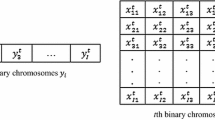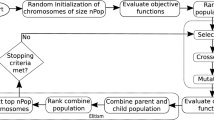Abstract
A bi-objective stochastic capacitated multi-facility location–allocation problem is presented where the customer demands have Bernoulli distributions. The capacity of a facility for accepting customers is limited so that if the number of allocated customers to the facility is more than its capacity, a shortage will occur. The problem is formulated as a bi-objective mathematical programming model. The first objective is to find optimal locations of facilities among potential locations and optimal allocations of stochastic customers to the facilities so that the total sum of fixed costs of establishment of the facilities and the expected values of servicing and shortage costs is minimized. The second objective is to balance the number of allocated customers to the facilities. To solve small problems, the augmented \(\varepsilon \)-constraint method is used. Also, two metaheuristic solution approaches, non-dominated sorting genetic algorithm II (NSGA-II) and controlled elitist non-dominated sorting genetic algorithm II (CNSGA-II), are presented for solving large problems. Several sample problems are generated and with various criteria are tested to show the performance of the proposed model and the solution approaches.













Similar content being viewed by others
References
Albareda-Sambola M, Fernańdez E, Laporte G (2007) Heuristic and lower bounds for a stochastic location routing problem. Eur J Oper Res 179:940–55
Albareda-Sambola M, Fernańdez E, Saldanha-da-Gama F (2011) The facility location problem with Bernoulli demands. Omega 39:335–345
Albareda-Sambola M, VanderVlerk MH, Fernańdez E (2006) Exact solutions to a class of stochastic generalized assignment problems. Eur J Oper Res 173:465–487
Alizadeha M, Mahdavi I, Mahdavi-Amiri N, Shiripour S (2016) Modeling and solving a capacitated stochastic location-allocation problem using sub-sources. Soft Comput 20(6):2261–2280
Berman O, Drezner Z, Tamir A, Wesolowsky GO (2009) Optimal location with equitable loads. Ann Oper Res 167:307–325
Berman O, Kaplan EH (1990) Equity maximizing facility location schemes. Transp Sci 24:137–144
Bongartz I, Calamai PH, Conn AR (1994) A projection method for lp norm location-allocation problems. Math Program 66:283–312
Boukani FH, Moghaddam BF, Pishvaee MS (2014) Robust optimization approach to capacitated single and multiple allocation hub location problems. Comput Appl Math 76:1091–1110
Bozorgi-Amiri A, Jabalameli MS, Alinaghian M, Heydari M (2012) A modified particle swarm optimization for disaster relief logistics under uncertain environment. Int J Adv Manuf Technol 60(1–4):357–371
Brandeau ML, Chiu SS (1989) An overview of representative problems in location research. Manag Sci 35:645–74
Cooper L (1963) Location-allocation problems. Oper Res 11:331–344
Cortinhal MJ, Captivo ME (2003) Upper and lower bounds for the single source capacitated location problem. Eur J Oper Res 51(151):333
Current J, Daskin M, Schilling D (2002) Discrete network location models. In: In Drezner Z, Hamacher HW (eds) Facility location: applications and theory‘. Springer, Berlin, pp 81–118
Drezner T, Drezner Z, Guyse J (2009) Equitable service by a facility: minimizing the Gini coefficient. Comput Oper Res 36:3240–3246
Eiselt HA, Laporte G (1995) Objectives in location problems. In: Drezner Z (ed) Facility location: a survey of applications and methods. Springer, Berlin
Erkut E (1993) Inequality measures for location problems. Locat Sci 1:199–217
Galvao RD, Espejo LGA, Boffey B, Yates D (2006) Load balancing and capacity constraints in a hierarchical location model. Eur J Oper Res 172:631–646
Ghosh A, Rushton G (1987) Spatial analysis and location-allocation models. Van Nostrand Reinhold Company, New York
Hakimi S (1964) Optimum distribution of switching centers in a communication network and some related graph theoretic problems. Oper Res 13(1):462–475
Kalcsics J, Nickel S, Schröder M (2005) Towards a unified territory design approach—applications, algorithms and GIS integration. TOP 13:1–56
Kalcsics J, Nickel S, Puerto P, Rodríguez-Chía A (2010) The ordered capacitated facility location problem. TOP 18:203–222
Kalyanmoy D (2001) Multi-objective optimization using evolutionary algorithms, vol 16. Wiley interscience series in systems and optimization. Wiley, Hoboken
Karp R (1972) Reducibility among combinatorial problems. Plenum, New York, pp 85–104
Kozanidis G (2009) Solving the linear multiple choice knapsack problem with two objectives: profit and equity. Comput Optim Appl 43:261–294
Louveaux F (1993) Stochastic location analysis. Locat Sci 1:127–54
Marín A (2011) The discrete facility location problem with balanced allocation of customer. Eur J Oper Res 210:27–38
Marín A, Nickel S, Velten S (2010) An extended covering model for flexible discrete and equity location problems. Math Methods Oper Res 71:125–163
Marsh MT, Schilling DA (1994) Equity measurement in facility location analysis: a review and framework. Eur J Oper Res 74:1–17
Mavrotas G (2009) Effective implementation of the e-constraint method in multi-objective mathematical programming problems. Appl Math Comput 213:455–465
Mousavi M, Niaki T (2013) Capacitated location allocation problem with stochastic location and fuzzy demand: a hybrid algorithm. Appl Math Model 37:5109–5119
Mousavi M, Niaki T, Mehdizadeh E, Tavarroth M (2013) The capacitated multi-facility location-allocation problem with probabilistic customer location and demand: two hybrid meta-heuristic algorithms. Int J Syst Sci 44(3):1897–1912
Murali P, Ordóñez F, Dessouky MM (2012) Facility location under demand uncertainty: response to a large-scale bio-terror attack. Socio Econ Plan Sci 46(1):78–87
Park G, Lee Y, Han J (2014) A two-level location-allocation problem in designing local access fiber optic networks. Comput Oper Res 51:52–63
Rahmaniani R, Rahmaniani G, Jabbarzadeh A (2014) Variable neighborhood search based evolutionary algorithm and several approximations for balanced location-allocation design problem. Int J Adv Manuf Technol 72:145–159
Shiripour S, Mahdavi-Amiri N, Mahdavi I (2017) A transportation network model with intelligent probabilistic travel times and two hybrid algorithms. Transp Lett 9(2):90–122
Snyder LV (2006) Facility location under uncertainty: a review. IIE Trans 38:537–54
Weber A (1909) ubre den standort der Industrien, 1909; translated as Alfred Weber’s theory of the Location of Industries. University of Chicago press, Chicago
Yesilkokcen GN, Wesolowsky GO (1998) A branch-and-bound algorithm for the supply connected location-allocation problem on networks. Locat Sci 6:395–415
Zanjirani-Farahani R, Hekmatfar M (eds) (2009) Facility location: concepts, models, algorithms and case studies. Physica-Verlag, Berlin
Zarrinpoor N, Fallahnezhad MS, Pishvaee MS (2017) Design of a reliable hierarchical location-allocation model under disruptions for health service networks: a two-stage robust approach. Comput Ind Eng 109:130–150
Zhou J, Liu B (2003) New stochastic models for capacitated location-allocation problem. Comput Ind Eng 45(1):111–125
Zhou J, Liu B (2007) Modeling capacitated location-allocation problem with fuzzy demands. Comput Ind Eng 53(3):454–468
Zhao J, Verter V (2015) A bi-objective model for the used oil location-routing problem. Comput Oper Res 62:157–168
Acknowledgements
The first author acknowledges University of Garmsar and the second author thanks Sharif University of Technology for supporting this work.
Author information
Authors and Affiliations
Corresponding author
Ethics declarations
Conflict of interest
All authors declares that they have no conflict of interest.
Ethical approval
This article does not contain any studies with human participants or animals performed by any of the authors.
Additional information
Communicated by V. Loia.
Rights and permissions
About this article
Cite this article
Shiripour, S., Mahdavi-Amiri, N. Bi-objective location problem with balanced allocation of customers and Bernoulli demands: two solution approaches. Soft Comput 23, 4999–5018 (2019). https://doi.org/10.1007/s00500-018-3163-4
Published:
Issue Date:
DOI: https://doi.org/10.1007/s00500-018-3163-4




